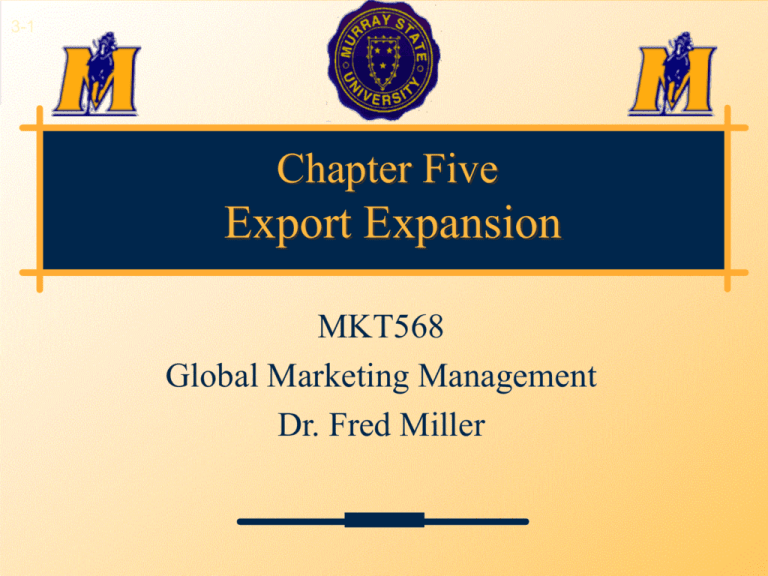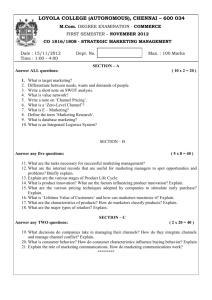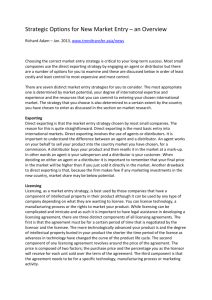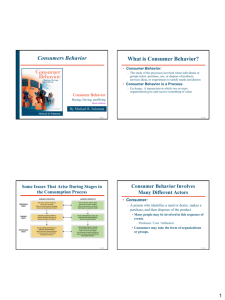
3-1
Chapter Five
Export Expansion
MKT568
Global Marketing Management
Dr. Fred Miller
Sample Essay Questions
Daimler-Chrysler
has perfected
new
engine
which
Nestle’s
Nescafe
brand
has a firmly
reputation
for
Schmidt’s
is a regional
brewer
in
theestablished
Unitedtechnology
States
which
wishes
allows
itsaround
new
Renewal
carThe
to get
40 to
mpg
cleanly
burning
quality
the world.
keys
thisbysuccess
are
to expand
to international
markets.
Though
profitable,
the firm
fuels
rangingproduction
fromproduction
animal
andstandards
vegetable
oilstightly
to gas,resources
ethanol and
has
limited
capacity,
modestand
financial
and
consistently
high
focused
biodiesel.
No competitor
closecountries.
to matching
this achievement.
no
experience
in international
marketing.
Which
entrymethod
method
promotional
efforts
in allishost
Which
entry
Which
entry
method
would be
most
appropriate
for Daimlerwould
be
most
appropriate
for
Schmidt’s
in:
would bein:
most appropriate for Nestle’s in:
Chrysler
Vietnam
Pakistan
Nigeria
Chile
Thailand
Brazil
Portugal
Australia
Canada
Describe
each unique
unique method
method briefly
briefly and
explain
how it
it
Describeeach
each
andexplain
explainhow
how
Describe
unique
method
briefly
and
it
balances
the
following
factors:
1)
financial
resources
required,
balances
the
following
factors:
1)
financial
resources
required,
balances
the
following
factors:
1)
financial
resources
required,
2)
investment
risk,
3)
control
of
marketing
strategy,
and
4)
2)investment
investmentrisk,
risk,3)
3)control
controlof
ofmarketing
marketing strategy,
strategy,and
and4)
4)
2)
protection
of
intellectual
property.
protection
of
intellectual
property.
protection of intellectual property.
Global Marketing Decisions in this Chapter
What types of entry barriers do global
marketers encounter? How do they affect
market entry decisions?
What are the advantages and disadvantages of
each market entry option?
How should marketers match market entry
methods with competitive strategies and
countries?
Entry Barriers
Tariff barriers
Tariffs
Quotas
Nontariff barriers
Government regulation
Product/safety/environmental restrictions
Financial/operating/business restrictions
Natural barriers – strong competitors
Distribution in mature markets
Promotion budgeting in USA
Global Marketing Decisions in this Chapter
What types of entry barriers do global marketers
encounter? How do they affect market entry decisions?
What are the advantages and disadvantages of each
market entry option?
Exporting
How should marketers match market entry methods with
competitive strategies and countries?
Methods of Entry
Entry method
exporting - direct , indirect
licensing, franchising, contract
manufacture/management
strategic alliances (activities), joint ventures
(equity)
foreign direct investment, sales, production,
greenfield, acquisition
Exporting Activities
Direct and indirect exporting
The Exporting Job
shipping, documentation, legal issues, shipping terms
securing local distributors, process and agreement terms
getting paid, letter of credit cycle, Trade Card
Export Expansion Strategy
cultural distance, international learning curve/sequence
sprinkler (diversification) and waterfall (focus) strategies
Principal Documents Used in Exporting
required by
Foreign Customer
U.S. Government
1. Pro forma invoice
1. Export Declaration
2. Acceptance of purchase orders
2. Export license (strategic
goods and shipments to
designated unfriendly nations)
3. Ocean (airway) bill of lading
4. Certificate (or policy) of insurance
5. Packing list
Foreign Governments
1. Certificate of origin
Exporting manufacturer
2. Customs invoice
1. Purchase order
3. Consular invoice
2. Letter of credit or draft (trade) acceptance
Exporter’s bank
Freight forwarder
1. Exporter’s draft
1. Shipper’s letter of instructions
2. Commercial invoice
2. Domestic (inland) bill of lading
3. Consular invoice
3. Packing list
4. Insurance certificate
4. Commercial invoice
5. Ocean (airway) bill of lading
5. Letter of credit (original copy)
Exhibit 5.3
Source: Adapted from Root, 1987, p.71. ©1987 by Jossey-Bass, Inc., Publishers. First published by Lexington
Books. All rights reserved
Criteria for Choosing Distributors
Previous experience (products handled, area covered, size)
Services offered (inventory, repairs, after-sales service)
Marketing support (advertising and promotional support)
Financial strength
Relations with government
Cooperativeness
Whether or not handling competing products
Master Foreign Distributorship Agreement Checklist
Confidential Information
Sales liter atur e
Advertis ing literature
Quantities
M ailing lis ts
T rademarks and Copyr ights
No warr anty agains t infringement
No Cons equential damages -indemnity
P roduct war ranty
Relationship between parties
Effective date and dur ation
E ffective date and term
E arly termination
Breach
Insolvency
Prospective breach
Change in owners hip or management
Rights and obligations upon termination
No liability for principal
Return of promotional materials
Repurchas e of stock
Accrued rights and obligations
Noncompetition
No as signment
Gover nment regulation
Foreign law
U. S. Law
Foreign Corrupt Practices Act
Force majeur e
Separability
W aiver
Notices
W ritten notice
Oral notice
Arbitration
ICC rules
J urisdiction
Article titles
Entir e agreement and
modification
E ntire agreement
M odifications
Source: Adapted from Hall, 1993, pp.65-66.
Courtesy of Unz & Co.
Master Foreign Agency Appointment Checklist
Appointments
T er ritory-P roducts
Sales Activities
Promotional Efforts
Introductions (optional)
Prices
Acceptance
Agent Representations
M inimum Orders (optional)
Increase Orders (optional)
Agent Facilities
Competitive Products
Confidential Information
Reports
Operations Report
Credit Information
Visits to Agent Pr emises by
Representatives of Pr incipal
Sales Literatur e
T rademarks and Copyr ight
Acceptance of Order s and Shipments
Acceptance
No Violation of U. S. Laws
Commiss ions
Commiss ion Percentage
Accrual
Refund
Dis continuation of Products
Repair and Rework
Relationship Between Parties
Sub-Agent
No Warr anty Agains t Infringement
P roduct W ar ranty
Effective Date and Dur ation
E ffective Date and Term
Breach
Insolvency
Prospective Breach
Change in Owners hip or Management
Foreign Protective Act
Source: Adapted from Hall, 1993, pp67-68.
Courtesy of Unz & Co.
Letter of Credit Model
Exporter
seller
beneficiary
7. Remits payment
Exporter’s
bank
6. Presents documents
1. Purchase and
agreement
5. Shipment of goods
Importer
buyer
account
party
Exhibit 5.6
10. Sends documents
11. Pays bank or gets loan
9. Remits payment
2. L/C application
3. Opens L/C
United States
Overseas
8. Presents documents
for negotiation
4. Advises of L/C
Importer’s
bank
Letter of Credit Cycle
It’s a deal!!
Ordering a Letter of Credit
You are Director of Procurement Services for Schmidt’s
Brewing Company. You must order the letter of credit
for a shipment of Czech hops for Schmidt’s new export
brand.
If you wish the purchase price to include shipping and
insurance costs to New York, the port of entry, which
shipping terms will you specify?
Why is it important that your list of required documents
be accurate and complete?
What documents will you require your supplier to
provide to receive payment?
How will you confirm that you have included all the
necessary documents?
Exporting Activities
Direct and indirect exporting
The Exporting Job
shipping, documentation, legal issues, shipping terms
securing local distributors, process and agreement terms
getting paid, letter of credit cycle, Trade Card
Export Expansion Strategy
cultural distance, international learning curve/sequence
sprinkler (diversification) and waterfall (focus) strategies
Price Escalation
Causes
tariffs, costs, intermediaries, taxes
Cures
lower quality/margins, different
classification/channels, local assembly/manufacture
(FTZ’s)
Example
International Price Escalation Effects (in
U.S. Dollars)
International marketing channel elements
and cost factors
+ wholesaler’s margin (33 1/3% on cost)
+V.A.T. (16% on margin)
=Local foreign jobber’s cost
(=wholesale prices)
+jobber’s margin (33 1/3% on cost)
+V.A.T. (16% on margin)
=Retailer’s cost (=Wholesale or jobber
price)
+retailer’s margin (50% on cost)
+V.A.T. (16% on margin)
=Retail price (what consumer pays)
Percent price escalation over: Domestic
Case 1
(same as
domestic
Domestic with direct
wholesal wholesale
e-retail
import
channel c.i.f./tarrif)
2.00
2.00
2.00
3.40
3.40
3.40
Case 2
(same as
Case 1
with
foreign
importer
added to
channel
4.25
4.25
4.25
2.00
2.00
8.00
3.40
2.00
13.60
4.25
4.25
17.00
4.00
4.00
$12.00
6.80
6.80
$20.40
70%
8.50
8.50
$25.50
113%
25%
Case 1
Market Factors Affecting Choice of
Expansion Path
Factors
Growth rate
Demand stability
Competitive lag
Spillover
Need to adapt product
Need to adapt promo
Marginal sales
Need for control
Entry barriers
Exhibit 5.8
Sprinkler/
Diversify if
Low
Low
Short
High
Low
Low
Diminishing
Low
Low
Waterfall/
Focus if
High
High
Long
Low
High
High
Increasing
High
High
3-1
Chapter Six
Licensing, Strategic Alliances, FDI
MKT568
Global Marketing Management
Dr. Fred Miller
Global Marketing Decisions in this Chapter
What types of entry barriers do global marketers
encounter? How do they affect market entry decisions?
What are the advantages and disadvantages of each
market entry option?
Licensing and franchising
How should marketers match market entry methods with
competitive strategies and countries?
Forms of Licensing
Straight licensing
royalty, fees, supply contract
Franchising
fee, royalty, promotion, supply contract
Turnkey projects
payment, management contract
Original Equipment Manufacturing (OEM)
technically an export method
risk structure of licensing
6-4
Elements of a Licensing Contract
Technology package
Use conditions
Field of use of licensed technology
Territorial rights for manufacture and sale
Sublicensing rights
Know-how to be supplied and its
Safeguarding trade secrets
method of transfer
Responsibility for defense/infringement
action on patents and trademarks
Supply of raw materials, equipment, Exclusion of competitive products
and intermediate goods
Exclusion of competitive technology
Maintenance of product standards
Performance requirements
Rights of licensee to new products and
technology
Reporting requirements
Auditing/inspection rights of licensor
Reporting requirements of licensee
Definition/description of t he
licensed industrial property
Global Marketing Decisions in this Chapter
What types of entry barriers do global marketers
encounter? How do they affect market entry decisions?
What are the advantages and disadvantages of each
market entry option?
Alliances and JVs
How should marketers match market entry methods with
competitive strategies and countries?
Strategic Alliances
Non-equity alliances
distribution
Heineken’s June 2004 agreement with FEMSA to distribute Sol and Dos
Equis throughout USA and, later, joint distribution in South America
manufacturing
research and development
Equity alliances
joint ventures
Global Marketing Decisions in this Chapter
What types of entry barriers do global marketers
encounter? How do they affect market entry decisions?
What are the advantages and disadvantages of each
market entry option?
Foreign direct investment
How should marketers match market entry methods with
competitive strategies and countries?
Foreign Direct Investment
Advantages
lowers price escalation effects
avoids tariffs
establishes local presence, increases learning
possibilities
Additional risk elements
degree of financial commitment
political risk
country-of-origin effects
Greenfield vs acquisition
Global Marketing Decisions in this Chapter
What types of entry barriers do global marketers
encounter? How do they affect market entry decisions?
What are the advantages and disadvantages of each
market entry option?
Licensing and franchising
How should marketers match market entry methods
with competitive strategies and countries?
Selecting an Entry Method
Relative to competitive position and strategy
incremental entry, with relatively few resources
protected technology or expertise FSA
control over production and marketing
Relative to market type
Emerging
New growth
Mature
Decision matrix
An Optimal Entry Mode Matrix
Company
strategic
posture
Emerging
High-growth
Mature
Services
Incremental
Indirect
exports
Indirect exports
Direct exports
Licensing/
Alliance
Protected
Joint
venture
Indirect exports
Alliance/
Licensing
Licensing
Wholly
owned
subsidiary
Acquisition/
Alliance
Wholly owned
subsidiary
Franchising/
Alliance/
Exporting
Control
Exhibit 6.3
Product/Market Situation
3-1
Chapter Six
Licensing, Strategic Alliances, FDI
MKT568
Global Marketing Management
Dr. Fred Miller






